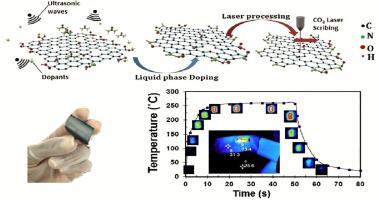Our official English website, www.x-mol.net, welcomes your
feedback! (Note: you will need to create a separate account there.)
Ultrasonic Doping and Photo-reduction of Graphene Oxide Films for Flexible and High-Performance Electrothermal Heaters
FlatChem ( IF 5.9 ) Pub Date : 2020-11-01 , DOI: 10.1016/j.flatc.2020.100199 Sandra A.N. Tembei , Ahmed M.R. Fath El-Bab , Amr Hessein , Ahmed Abd El-Moneim
FlatChem ( IF 5.9 ) Pub Date : 2020-11-01 , DOI: 10.1016/j.flatc.2020.100199 Sandra A.N. Tembei , Ahmed M.R. Fath El-Bab , Amr Hessein , Ahmed Abd El-Moneim

|
Abstract Thermotherapy has emerged as one of the most promising treatments for arthritis, a prevalent, crippling, painful bone disease. This demands more flexibility, energy-efficiency, safety, and light-weight in thermotherapy packs and hot clothing. Heteroatom doping is a metal-free, cost-effective way to improve carrier concentration and hence electrical and thermal conductivity in reduced Graphene Oxide (rGO) thus rendering it suitable for wearable joule heaters. However, the current doping techniques result in complex chemical structures that hinder phonon propagation and suffer other problems such as low yield, low scalability, and rigidity of the final product. Here, we disclose a novel and facile, low-temperature technique for nitrogen doping and photoreduction of graphene oxide (GO) films for high-performance, flexible graphene-based electrothermal heaters. The nitrogen atoms are introduced into the GO lattice with the aid of ultrasonic power in a wet chemical doping phase and maskless, automated, rapid CO2 laser scanning is used for the concurrent removal of oxygen-containing functional groups and the rearrangement of nitrogen atoms in the graphene lattice. X-ray Photoelectron Spectroscopy (XPS) studies reveal up to 5.43% nitrogen dopant concentration with a high carbon to oxygen ratio of 16, while Raman studies uniquely show improved atomic ordering with ID/IG ratio of 0.51 in the nitrogen-doped Laser reduced graphene oxide (N-LrGO) films. The fabricated N-LrGO heater has a sheet resistance of 26 O/sq. and attains a higher steady-state temperature of up to 245.7 °C at a low driving voltage of 9 V with a low power demand of 0.7 Wcm−2 and a heating rate of 103 °C/s. Its excellent temperature distribution and high flexibility join with the scalability of the preparation technique to demonstrate great potential for its incorporation with next-generation wearable electronics powered by low voltage portable energy storage devices.
中文翻译:

用于柔性和高性能电热加热器的氧化石墨烯薄膜的超声掺杂和光还原
摘要 热疗已成为治疗关节炎最有希望的治疗方法之一,关节炎是一种流行的、致残的、疼痛的骨病。这要求热疗包和热衣具有更大的灵活性、能效、安全性和轻便性。杂原子掺杂是一种无金属、经济高效的方法,可以提高载流子浓度,从而提高还原氧化石墨烯 (rGO) 的导电性和导热性,从而使其适用于可穿戴焦耳加热器。然而,目前的掺杂技术会导致复杂的化学结构,阻碍声子传播并遭受其他问题,例如低产率、低可扩展性和最终产品的刚性。在这里,我们公开了一种新颖且简便的低温技术,用于氧化石墨烯 (GO) 薄膜的氮掺杂和光还原,以实现高性能,基于柔性石墨烯的电热加热器。在湿化学掺杂阶段,借助超声波功率将氮原子引入 GO 晶格中,并使用无掩模、自动化、快速的 CO2 激光扫描来同时去除含氧官能团和重排 GO 中的氮原子。石墨烯晶格。X 射线光电子能谱 (XPS) 研究显示氮掺杂剂浓度高达 5.43%,碳氧比高达 16,而拉曼研究独特地显示了氮掺杂激光还原石墨烯中 ID/IG 比为 0.51 的改善的原子排序氧化物 (N-LrGO) 薄膜。制造的 N-LrGO 加热器的薄层电阻为 26 O/sq。并在 9 V 的低驱动电压和 0 的低功率需求下实现高达 245.7 °C 的更高稳态温度。7 Wcm−2 和 103 °C/s 的加热速率。其出色的温度分布和高灵活性与制备技术的可扩展性相结合,展示了其与由低压便携式储能设备供电的下一代可穿戴电子设备结合的巨大潜力。
更新日期:2020-11-01
中文翻译:

用于柔性和高性能电热加热器的氧化石墨烯薄膜的超声掺杂和光还原
摘要 热疗已成为治疗关节炎最有希望的治疗方法之一,关节炎是一种流行的、致残的、疼痛的骨病。这要求热疗包和热衣具有更大的灵活性、能效、安全性和轻便性。杂原子掺杂是一种无金属、经济高效的方法,可以提高载流子浓度,从而提高还原氧化石墨烯 (rGO) 的导电性和导热性,从而使其适用于可穿戴焦耳加热器。然而,目前的掺杂技术会导致复杂的化学结构,阻碍声子传播并遭受其他问题,例如低产率、低可扩展性和最终产品的刚性。在这里,我们公开了一种新颖且简便的低温技术,用于氧化石墨烯 (GO) 薄膜的氮掺杂和光还原,以实现高性能,基于柔性石墨烯的电热加热器。在湿化学掺杂阶段,借助超声波功率将氮原子引入 GO 晶格中,并使用无掩模、自动化、快速的 CO2 激光扫描来同时去除含氧官能团和重排 GO 中的氮原子。石墨烯晶格。X 射线光电子能谱 (XPS) 研究显示氮掺杂剂浓度高达 5.43%,碳氧比高达 16,而拉曼研究独特地显示了氮掺杂激光还原石墨烯中 ID/IG 比为 0.51 的改善的原子排序氧化物 (N-LrGO) 薄膜。制造的 N-LrGO 加热器的薄层电阻为 26 O/sq。并在 9 V 的低驱动电压和 0 的低功率需求下实现高达 245.7 °C 的更高稳态温度。7 Wcm−2 和 103 °C/s 的加热速率。其出色的温度分布和高灵活性与制备技术的可扩展性相结合,展示了其与由低压便携式储能设备供电的下一代可穿戴电子设备结合的巨大潜力。











































 京公网安备 11010802027423号
京公网安备 11010802027423号